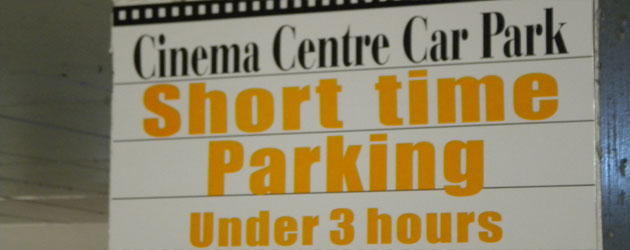
I had already published articles about the unfathomable prices of parking at Secure Parking and at Wilson Parking. Wilson lures people with an attractive offer that is not as good as it seems. Secure shouts with massive signs that are as confusing (and therefore as misleading) as mobile phone rate-cards. This article is useful to managers who would like to learn more about pricing strategies and the destruction of consumer confidence. Although this article uses two parking stations as an example, it is designed to assist senior managers to delve into pricing models that could well be destroying the brand though invisible unscrupulous practices.
In this previous article about Secure Parking, I had commented about the rates that jump all over the place. Three weeks after posting that article, we now have yet another price change. If someone at either company knows what they are doing, they might do well to study this analysis, and perhaps they can tell us how the client is supposed to make head or tail out of these rates.
Consumers are used to seeing prices increase. They would not be baffled if someone had raised the price of something from $10 to $12 to $14. Consumers could assume that the company is either greedy, or that the price of raw materials had gone up, or some such excuse. However, in the case of Secure Parking and Wilson Parking stations, the logic is way beyond even the most seasoned of mathematicians and actuaries. This report focusses on two stations that are both on Sussex Street in Sydney. These are stand-alone operations, only six buildings apart. They both occupy the entire building in which they operate, so we do not have to suffer any disparaties in terms of comparison (becasue some stations are under corporate tower blocks and shopping centres).
Let us analyse their pricing strategies. First, note that within a short period of time, Secure Parking had three price changes that do not make sense to me. They went from a ‘From $5’ inducement to a ‘From $6’ inducement and changed the exit time to an hour earlier during weekdays. During Friday and Saturaday nights, entry was changed by one hour in what seems to be in the customer’s favour, but later you will see that this was a clever hook; more like honey to catch flies.
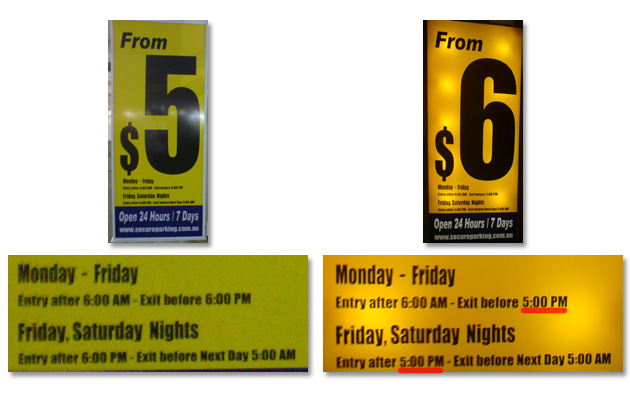
Look at the photo below. One wonders what the deep thinking was behind the logic of the tactics that moves the 1st bracket up by one dollar. Then the 2nd bracket remains unchanged. The 3rd goes up by one dollar, then the 4th by two dollars, and the 5th by three dollars. According to this new price list, if you park for four hours, you pay the equivalent of $11.25 per hour. But if you park for 24 hours, you pay $1.88 per hour. How can it be that Secure Parking is satisfied with $1.88 per hour, but charges $11.25 per hour if you park for four hours? Is this because they know that most casuals stay for approximately four hours, and this means that they are charged the maximum rate quick-smart to catch everyone in the net? It’s like saying, ‘Give me everything now, and show me that you love me.’ Also in the photo below, the rates on the left went from $24 to $32 which is a jump of $8. The second set of rates (right side photo) went from $25 to $34 which is a jump of $9. That seems sneaky to me. Not only did the price increase, the gap between the two was also increased. I am waiting for the day that they introduce the 99-cent suffix to end up with $6.99 and $45.99. Also below we see an earlier exit requirement for early-bird parkers. Seems sneaky to intrudce the 24-hour army-style of telling the time. If everything on that page is 6:00 am and 10:00 am, why must 2:30 become 14:30? They can’t say it’s for clarity, because they differentiate with the ‘am’ and ‘pm’ suffixes in all other cases. Early-birds were first required to park their car and walk to 9b (that could be good exercise). Later, they were asked to ‘drive’ to 9b first in order to validate their tickets. Perhaps people were cheating or something.

The strangest of all terms is the one that says, ‘Rate apply from entry time to time per 24 hours period’. Please read this over and over and see if you can make sense of it. That is either one of those mega-clever statements designed to trap anyone who opens their mouth, or it is an abbreviated version of complex indecipherable legalese, or it is in response to a few people who have found a loophole in the system. Either way, no-one understands it. And I suspect that if it led to a legal showdown, no judge would accept that the average person could have been deemed to have been given fair warning, because the language was nonsensical. So, why is it there? Is that to cope with people who park for 26 hours, and they would be expected to pay $45 plus another two hours based on the rate at the time, depending… blah blah blah? Why not just sell it all at one rate per hour and let people park until their heart’s content. Besides, it seems that companies always write their legals to cope with a few underhanded unreasonable customers, and as a result, they confuse all the regular decent cleints. I have seen young drivers physically ligft the boom-gate and drive off without paying. Is it worth anyone’s time to trace the anomaly in the day’s takings, or to pursue the matter in court? I wish they would, but I doubt they would. So if all this is meant to cope with someone who parks for 26 hours or even 126 hours, what’s stopping them from driving their mate’s vehicle in, and using that ticket to pay for 30 minutes. And then the mate can declare a missing ticket, which comes to $45. Do they have a policy for that? There are way too many cheats out there, but in the end, do not bamboozle everyone, in order to cope with a handfull of idiots who will break any rule, and who will not be pursued for their petty crimes.
Before we delve even further into the strategies, let us now conduct the same query by looking at the differences between the second price rise and the third (below). At face value, it seems that the price went down. Alas not. Why did Secure Parking reduce the rate for the first 30 minutes of parking from $6 to $5? Was this benevolence? Customer service? A favour to the City of Sydney? Or was it just a way to compete with Wilson parking down the road? We will compare the two companies shortly. Meanwhile, what has changed between the second rate rise and the third, which took place within a matter of weeks? In the world of parking, there seems to be something significant about the second and third hour. Is that the ‘sweet spot’ as far as statistics are concerned? In the first rate-card in the photo (above left), we saw that the rate moved up the ladder from $24 to $32. The second rate-card (above right) went from $25 to $34.
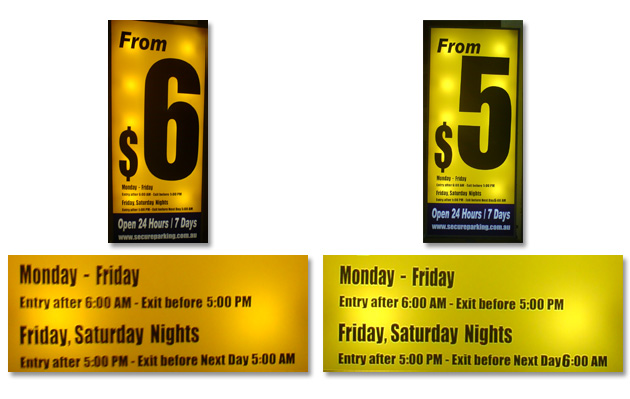
The third rate-card shown below-right, the price went from $28 to $38. That’s a category jump of $10. So far we have seen deltas of $8, $9, and $10. Note again that these are not price increases, but category jumps on top of the price increases. That is a subtle yet clever distrinction. The average punter would see the entry price and the maximum price. At face value, we see the entry price as $5 and the maximum at $45. On the whole, one could presume that the rate card went in the customer’s favour. The photo below-left shows it going from $6 to $45 and then it changed (bottom right) from $5 to $45. That seems dandy. But the real change ocurred in the middle. $25 became $28 and $34 became $38. So the incrase (within this seemingly decreasing benevolent rate-card) went up by three dollars and then it zigzaged up the category scale by a jump of $10. Any business can charge what it likes. But this not a matter of raising the price, but of manipulating the core rates while disguising the truth with smoke and mirrors. That is the bit to which I am objecting. It does not point to sound management practices. The core of any company needs to be wholesome, and these tactics do not point to sound wholesome practices.
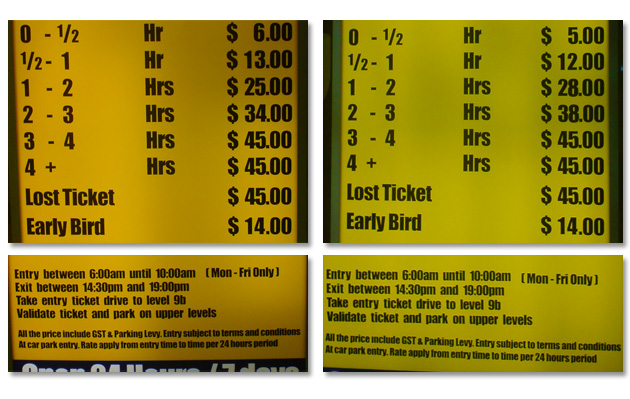
From the rates above, we can see that it all centres around the second and third hour. Anyone who parks for two hours is paying $14 per hour. And if they park for three hours, they are paying $12.67 per hour. Why is it so expensive at that combination, when Secure Parking is happy to say that anyone can park for 24 hours for only $1.88 per hour. That’s not a sliding scale. That is a sheer drop. Anything up to four hours comes to $11.25 per hour and then there is a cliff. It drop to $1.88 per hour. The is nothing sliding if one plots the graph where it all starts at the equivalent of $10 per hour and goes to $11.25 and then a massive drop to $1.88. That does not polt a bell curve. It does not plot a sliding scale. It does not point to economies of scale. And here is why: the company speaks to us in its rate card. It says, please enter at the equivalent of $10 per hour. If you stay for 31 minutes, you now owe us $12. This is not the direction of a sliding scale! Then it says, if you have the hide to stay one minute over one hour, just one minute over, you owe us $28 which is $12.67 per hour. If you stay one minute over two hours, you owe us $38 which is $11.25 per hour. But this is all misleading, because if someone does stay for one minute over two hours, then it is no longer correct to say that it is $11.25 per hour. This in fact is 121 minutes at $38 which comes to $18.84 per hour.
So now we ask, how can a company entice people with a $5 offer, when anyone who stays a minute over two hours is really paying $18.84 per hour which comes to $38.00?
 Why promote a service at $5 entry, when I suspect that the overwhelming majority of a parkers would not leave the carpark in under thirty minutes. Anyone going in on a Friday or Saturday evening is most definitely going in for a function, a night on the town, or a dinner and movie (remember that this establishment is officially called the Cinema Centre Car Park). So why display a massive sign that promotes $5? This is not the kind of business practice in which any ethical company ought to engage.
Why promote a service at $5 entry, when I suspect that the overwhelming majority of a parkers would not leave the carpark in under thirty minutes. Anyone going in on a Friday or Saturday evening is most definitely going in for a function, a night on the town, or a dinner and movie (remember that this establishment is officially called the Cinema Centre Car Park). So why display a massive sign that promotes $5? This is not the kind of business practice in which any ethical company ought to engage.
SHORT-TERM PARKING MAKES ALL THE PROFITS
 One more thing before we move on. Supermarkets have a special lane for people with 12 items or fewer. This was introduced to serve shoppers who did not think it fair to wait ten minutes to pay for a packet of gum. The supermarkets were encouraging small-value transactions. Now let us look at this new set of signs by Secure Parking (Wilson Parking has a similar section) that say ‘Short time parking: Under 3 hours’. This off is completely different from that made by supermarkets. The short-time parking bays are not a service to short-time clients. Rather, it is a service to Wilson Parking’s shareholders. These bays are on the lower entry levels. They are prime spots designed to make it easy for short-term visitors to access the car park. Why? Because anything under three hours is where all the profits are made. If these parking stations could have their wish, they would not want anyone to stay any longer than three hours. If the car-parks could be filled to capacity, by a high-turnover of people who leave in under three hours, they would be printing money hand over fist.
One more thing before we move on. Supermarkets have a special lane for people with 12 items or fewer. This was introduced to serve shoppers who did not think it fair to wait ten minutes to pay for a packet of gum. The supermarkets were encouraging small-value transactions. Now let us look at this new set of signs by Secure Parking (Wilson Parking has a similar section) that say ‘Short time parking: Under 3 hours’. This off is completely different from that made by supermarkets. The short-time parking bays are not a service to short-time clients. Rather, it is a service to Wilson Parking’s shareholders. These bays are on the lower entry levels. They are prime spots designed to make it easy for short-term visitors to access the car park. Why? Because anything under three hours is where all the profits are made. If these parking stations could have their wish, they would not want anyone to stay any longer than three hours. If the car-parks could be filled to capacity, by a high-turnover of people who leave in under three hours, they would be printing money hand over fist.
In a comedy sketch, Bob Newhart takes us into a driving school for bus drivers. The instructor teaches the class how to torment the customers by driving off while customers are chasing after the bus. He says that the driver must not drive too fast, lest the customer give us. He wants the customer to think that there is some hope of catching the bus. And when the customer becomes exhausted, the driver should accelerate. The instructor is teaching the art of tolerance. If you give people hope, they will not give up. A similar radio sketch was enacted by Tony Hancock, with Kenneth Williams as the instructor. In John Cleese’s TV documentary called, ‘How to irritate people’, Cleese says that when irritating someone, you want to remain irritating and annoying, just up until the victim is about to explode, but stop short of giving the victim that satisfaction. Irritate just enough and then stop. Do not allow you victim to hit the roof. Leave them angry but not enraged, so that they do not let off any steam. These are lessons in tolerances. It seems to me that the parking rates follow this wisdom. Charge people heaps of money up front, but make it sting at the high end, so that parkers say to themselves, ‘Gosh this is expensive. I am going to try to get out of here before it reaches $45 ($53 in Wilson’s case)’. In most businesses, customers are encouraged to consume more. The more they consume, the better it is for the business and the client. In this case, the spaces are limited, and so ‘turn-over’ is the name of the game. Both stations do not want people to linger. The top rates of $45 and $53 are not designed for the 24-hour stayer. They are designed to sting, in the hope that people leave. If a customer stays for 24 hours, Secure Parking makes $45. Whereas if a customer were to use the spot for 2 hours and 1 second, the company makes $455.
FLAT RATE OFFERS
I will not cover the early-bird rates in this article. But let us now look at the flat-rate offers. Below we see the change of rates within a few weeks of each other. What’s significant? On Mondays to Thursdays, we can now park for thirteen hours for $10. This works out at 77 cents per hour, yet a moment ago we could see that the company wanted $18.84 per hour. This is perhaps playing on the notion that business people are likely to park duing the day, and they tend to overlook such business expenses. Whereas in the evening, Secure Parking is speaking to the non-business crowd (people who might not claim such after-hours expenses against their company or Tax Department).
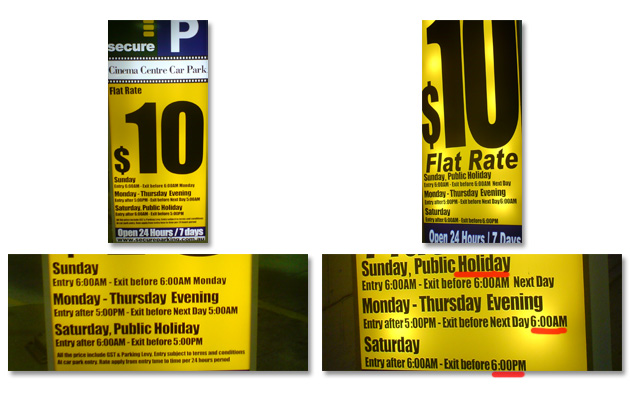
The other major observation is that the flat rates never apply to Fridays, and never to Saturday evenings. Yet, during Friday and Saturday nights, the enticing ‘From $5’ sign is displayed.
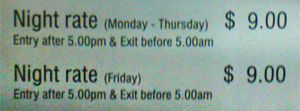
Down the road, the competitor, Wilson Parking, is offering Friday nights at a flat rate of $9, but I suspect that this will change after new customers form the habit or parking there, only to be bitten in due course if the company changes the night rate for Fridays. I say this because Wilson Parking has constructed new signage where Fridays have been separated. This seems to be a pre-emptive step in preparation of a major price differential when the iron get hot. But for now, Wilson’s $9 Friday night is a massive blow in competitive terms against Secure Parking a few hundred meters up the road. Of course, it is made difficult for consumers to favour one parking station over another. Both stations keep chopping and changing their rates (many more than I have shown here). In the end, we have to ask, what is it all about? Both stations are in Sussex Street. According or land valuations, how much different could one be from the other? As far as operating expenses, they bother operate in similar ways, offering concrete, lighting, and cleaning, with the odd security camera installed. So why and how can Wilson Parking offer Friday nights at $9 flat-rate while Secure Parking cannot? If someone parks for 10 hours on a Friday night, they would pay 90 cents per hour at Wilson and $4.50 per hour at Secure.
There are times when the parks are completely full. However, this is rare. People will pay $45 and $53 if they have no choice. So now we have to ponder if a business ought to adopt a pricing strategy based on a long-term, sustainable pricing model, or an opportunistic money-grabbing, greedy policies of charging whatever they can get away with, regardless of the damage or the confusion that it might cause. Does an existing board of directors not owe it to future of the business to ensure that genuine long-term strategies are in place to foster genuine long-term clients who can grow to trust the business, the brand, and the company. Does a management team not owe it to their own prfessionalism, ethics, and conscience to advice its CEO and the board about modern, ethical, sound management priactices that consider sustainability and growth, as opposed to instant myopic profits that not only destroy computer confidence, but puts the business in jeopardy?
WILSON PARKING
Wilson Parking has an article all its own. Read it here. By comparison, let us look at Wilson’s recent price increases. Below we see the old and the new rates. The photo on the right had an unfortunate flash light which obscured the the text. In fact, both old and new rates start at $7 for the first half hour. Then they both go up to $15, then $30, then $48. The only fee that changed was the 4+ hours to $53. What purpose could this serve? Is this trying to discourage people from staying any longer than four hours? Or could it have been due to a printing error in the first one, when it was not intended that $48 be printed. Was it also an oversight to have printed the illogical category of 4-5 hours, which begs the question: what happens after 5 hours?
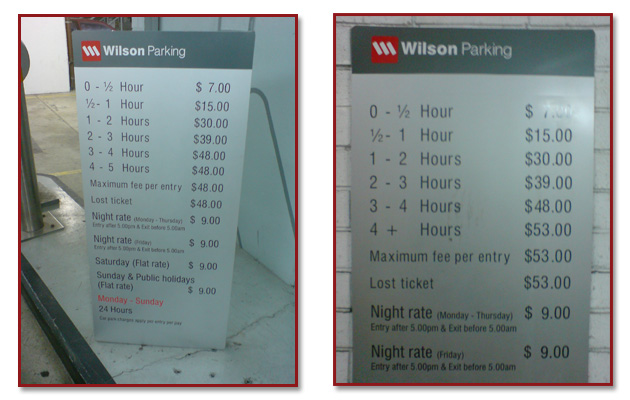
 If they were correcting errors, I wonder if they had missed this one: at the bottom of both signs is the legal nonsense that reads, ‘Car park charges apply per entry per pay’. Did they mean ‘per day’? Either way, it does not make sense to the average consumer.
If they were correcting errors, I wonder if they had missed this one: at the bottom of both signs is the legal nonsense that reads, ‘Car park charges apply per entry per pay’. Did they mean ‘per day’? Either way, it does not make sense to the average consumer.
WHAT CAN WE LEARN?
No-one would begrudge either company from wanting to maximise its investments. No-one should tell a company what it should charge for its services. I am merely noting the underhanded, the tricky, the misleading ways in which the company tries to communicate one thing, while trying to do another. It should have the audacity and the decency to face the facts and just call it out, and say, ‘We are in the business of making money, and we are trying to engineer an x-percent profit this year, and we have limited car spaces, so to achieve our goals, we will charge x-dollars per hour.’
Just call it out, up front, without the hideous ‘From $5’ which is an absurd rate from which no customers can benefit in the overall scheme of things.
In other words: Stop lying. Transacting ethically. There you go. Four words. That what this 3164-word article is trying to say.
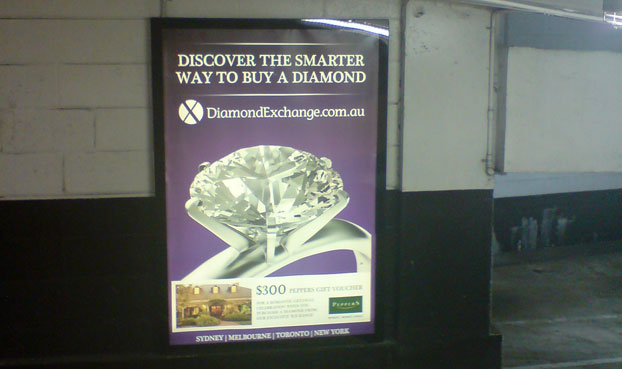



Comments are closed.